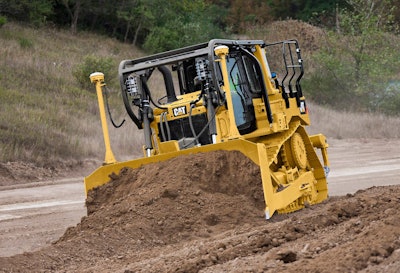 Photo: Caterpillar
Photo: CaterpillarIt doesn’t take long to evaluate a used car or truck but inspecting a piece of used equipment – whether it’s a beater or nearly new – requires several hours to a half a day. Anything you miss and have to repair or replace later will cost thousands if not tens of thousands of dollars.
So make a list. Be thorough. Take your time and carry a clipboard. After you’ve assessed the deficiencies, figure out each problem and what it would cost to fix, and adjust your bid accordingly.
While the general inspection points won’t apply to every machine – for instance, undercarriage inspection points on a wheeled machine – this will give you a good overview of what’s critical. Many operational checks will require two people: one to operate the machine and the other to observe how it performs. We also outline what’s key to examine in each of the major machine types.
Also, keep in mind that you can hire professionals to do this for you. Even if that seems expensive, it likely will save you money in the long run. Here’s what to look for:
Visual inspections
Engine compartment
With the machine cold, pull the dipsticks and check lube oil, coolant and hydraulic fluid levels.
Open the radiator cap and look for traces of oil in the coolant (if present, it will be floating on top in small drops).
Inspect hoses for leaks and condition. Check metal fuel and oil lines to make sure they’re not bent or kinked and to ensure connection points are tight.
Pull the air filter and note its condition.
Inspect radiators for bent or damaged fins. Radiators should be free of debris, and connection points leak – or drip – free.
Note any paint discoloration or bubbling on the engine cowlings or covers. This may indicate an overheating problem.
Look for leaks around gaskets, hydraulic pump, hoses and fittings.
Frame, boom stick
Look for hairline cracks in the metal. Ensure the welds are all solid and intact. Bushings should be intact and grease present. Inspect the hoses and fittings for leaks, kinks, wear or damage.
Keep in mind if the machine has been used to run a hammer, that has likely put a great deal of stress on the boom and stick and their linkages.
ROPS/FOPS
Look for cracks, bent or damaged metal. Note any cracks or damage to the windshield. Inspect door seals to make sure they’re crack- or damage-free and airtight.
Grab handles, access ladders and diamond plate/skid resistant surfaces should be intact and solidly mounted.
Hydraulic cylinders
Look for leaks, excessive oil coming past the cylinder wiper or pitting/scarring on the cylinder chrome. A film of dirt or dust may indicate the wiper needs replacing.
Latches and locks
These are small items but can be a nuisance and something that may need to be repaired. Test each one including the cab, battery box, fuel fill, engine hood or cowling, DEF access, cooling panel access.
Buckets and blades
Look for excessive or uneven wear or damage on bucket teeth and cutting edges. Check supporting linkages and cylinders for wear or damage.
Check to see if cutting edges are reversible or both edges are worn down.
Check that the bucket and/or blade sits level on the ground.
Tires
Check tread depth and inspect each tire for cuts and gashes.
Measure air pressure.
Inspect the sidewalls for cuts and bulges, which may indicate damage to the liner or steel belt and imminent failure.
Tires should be matched and worn evenly.
If the machine has been sitting for a while, look for dry rot, which will show up as faded color, brittleness and/or small cracks in the tread or sidewalls.
Linkages
Examine the machine for wear on all the pins and bushings throughout the linkage on the boom. Everything that has a grease zerk should have grease on it.
Steel undercarriage
Look for wear on the sprockets, rollers and track pads. “Sharp teeth” on the sprocket tell you it’s near the end of its useful life.
Look at the rail pins and bushings. As the pins and bushings wear internally, each track segment lengthens and becomes looser. To take up the slack, the front idler is moved forward in a bracket on the rails between the idler and the rear drive sprocket. There will come a point, however, when no further adjustments can be made. Some owners take a link out. While this makes the track look tighter, it also creates a tremendous amount of internal wear.
The best way to see if an undercarriage is worn out is to measure it using a track measuring group, which costs about $250 and is available from most dealers. With this, you can measure the grouser height, rails, links and carrier roller and guide roller tread diameter and bushings.
Rubber tracks
Inspect rubber tracks for worn track pads, cuts or gouges.
Look for wear or steel showing through on drive links.
Check track for proper tension, which indicates good maintenance.
Operational inspections
Engine
Turn the machine on and allow it to reach operating temperature while listening for any loud or unusual noises from the engine and/or cooling system, knocking or rough idle. Some exhaust smoke at startup is normal, but exhaust should clear quickly. White smoke indicates incomplete fuel burn and possibly leaky or malfunctioning injectors or restricted air intake. Black or blue smoke indicates that oil is getting by the cylinder rings or low compression.
Hydraulic cycles
Using a stopwatch, time how long it takes to fully retract the arm cylinder and fully extend the bucket cylinder, then raise and lower the boom, timing each up and down motion. To test the arm cylinder, with the bucket cylinder fully extended, time how long it takes to move the arm from the full-out position to the full-in position. Then time how long it takes to return to the full arm-out position again. Compare your times with manufacturer published times.
To test the track running speed, tie a ribbon on one of the track shoes on the side being tested, jack up the side where the track is being tested, then time how long it takes to do three track rotations at maximum speed. Apply the test to both tracks, forward and reverse. Also, tram the machine to make sure it travels in a straight line – if it veers one way or the other, you could have a weak pump.
Check for drifting – also called creeping – by raising the boom with a full load in the bucket, then turning the machine off. Wipe the oil off the boom cylinder rod and mark the measuring start point. After five minutes, measure again to see how much it has drifted down.
Each time the operator cycles the machine, check for any movement in the bushings.
Look at each bushing independently, instructing the operator to take the bucket completely off the ground. Loose pins and bushings are a key sign of how the machine has been treated.
Run the machine and hydraulics up to operating temperature, shut off and look under the machine for any fluids dripping leaks on the ground or horizontal surfaces in the engine compartment.
Emissions controls
With the engine running, make sure there are no warning lights on the dash indicating problems with the emissions controls, such as a DPF needing regeneration or an SCR system that is lacking in DEF fluid. If the previous owner is available, inquire about DPF maintenance schedules.
Machine-specific items
Skid steers
Look for evidence of over-the-tire tracks, which may cause wear spots on tires.
Driveline wear can be different with different skid steer brands. Check the chains. Loose is not a problem, but if you hear clatter, it could mean it has been loose for a while and may have damaged the sprockets. That could require an expensive repair.
Wheel loaders
The king pin/articulation joint carries all the load on a wheel loader and should be tight and flex free. Make sure all the grease fittings are intact and the top and bottom pins are vertically aligned. When you’re operating the bucket, have your inspection partner observe the top and bottom pins of the center pivot and note if there’s excessive up and down movement, which could indicate wear.
Excavators
If you can see any movement in a swing bearing, it’s probably too much. Beyond the visual inspection, use a magnetic dial indicator to take a measurement at four quarter-turn positions; an average of these four measurements will tell you what shape the machine’s swing bearing is in. Without this measurement, you’re guessing at the amount of wear in the swing bearing and this is a costly repair item.
Inspect final drives for leaks.
Dozers
If the dozer has a power-angle-tilt (PAT) blade, make sure it has full movement and the control cylinders are in good shape.
Inspect final drives for leaks.
Click here to download a sample inspection checklist.
EDITOR’S NOTE: This article was written by Tom Jackson, executive editor of Equipment World, a sister publication.











